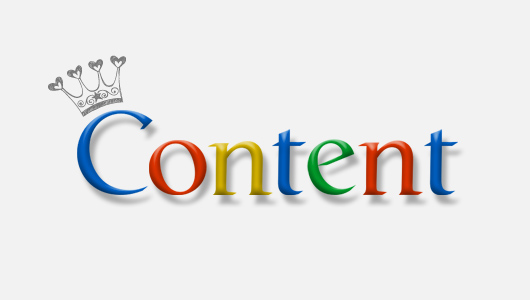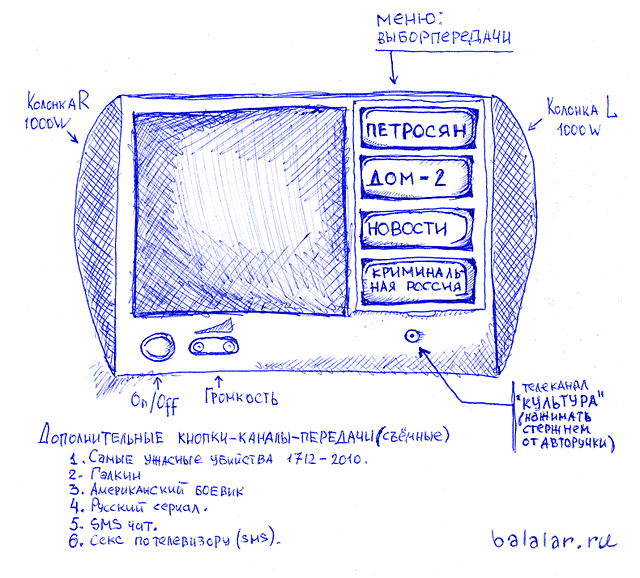Content vs. Technology

Every time I face TV, I turn into a zombie. Advertising, news, dvuhkopekichny series - all the same. The more stupid and clumsy the content, the stronger you stick to the screen. If one can giggle over Western serials, then on domestic ones you fall into a dull trance - you don't want anything. Intractable power of pure stupidity , otherwise you will not tell. I try in vain to unravel the secret - how do they do it? I do not suffer from a dopamine loop, rather easily filter information, I don’t read the 7 Days magazine, on the road I prefer to look out the window or inward, rather than into a smartphone. So what is this miracle of technology that chained me to a stupid screen?
When we started testing the “Fun” from Rostelecom, customer representatives when discussing Central Asia said a very encouraging thing: “In Russia, 90% of viewers watch TV passively. The task of providers is to teach and show that there is another way of looking,
that the user can not simply absorb what they give him. "
')
How do providers try to teach the viewer active watching? All conversations about the active viewer and interactive TV are conducted in the context of technology: set-to-box, over-the-top, smart TV, clouds, hard drives. Let's lean a little further back, in the pre-tech period, when multimedia shows were delivered directly, without any carriers. What was there with interactivity and choice?
I think I will not sin against history very much, if I draw such a line - rite / folklore -> theater -> cinema -> TV -> Internet.
The rite was a social act — he could have a moderator, but everyone participated in it. Folklore was originally also a collective work. Over time - we will write it off on the division of labor - a stratification into actors and spectators began. Here they are already separated by a ramp, the spectators are not visible in the darkness of the cinema hall, but they are fenced off with glass and kilometers. In short, interactivity has fallen until recently.
With a choice, the picture is reversed: a holiday or a performance with a selected set of participants - only here or now, the film could already go in many cities at the same time, and in a multiplex cinema one can choose both a film and a session. TV - a lot of channels, manage to click, Internet - open 10 players at once and watch 10 content streams.
As it is easy to understand from the selection curve, the uniqueness of the content falls. In fact, TV broadcast is a single repository for all channels. It makes no sense to choose a specific program or at least a specific channel, you can choose the type of content only. Where exactly it will be shown is important only for reasons of the share of advertising and the convenience of time.

This model belongs to the second half of the 23rd century,
when humanity refuses to divide the ether into channels,
and will divide it into transfers. (c) www.balalar.ru
Against this background, the rights holders of unique events such as football are probably terribly happy, as they can wring prices for the right to an exclusive show and for an advertising broadcast, respectively.
Combining the three curves (activity, uniqueness and choice), we get the trend: "a lot of non-unique content, separated and distant from the audience." That is, on a historical scale, the trend of interactivity is upstream. Perhaps the desire to introduce interactivity is an attempt to overcome the monstrous gap, to return - in a new form - to the sources, when we ourselves were creators of content.
When I was younger and more annoying, I was very angry with words like “I flew to Egypt”. “You didn't fly, but you were taken!” I growled. The same scheme is in TV: I watch or show me?
Of course, “I look” is not “I am creating” yet, but it is already better than “I am shown”. We will consider this a realistic ceiling for interactive TV.
Now there are two emphasis: on interactivity and on personality. In my opinion, there is no understanding of the strategy, under the sauce of interactivity and under the Smart TV brand they serve both, or all at once. Although these things are different in terms of user requirements.
But no matter how different these things are, and no matter how they try to submit, his majesty’s content comes onto the scene and mixes all plans, strategies and hopes. For it is in its mass, as has already been said: a) it is nonunique and impersonal; b) created for passive consumption. All the efforts of technology are reduced to nothing by content - it’s simply meaningless to choose or personalize which button you wouldn’t poke, the screen will remain essentially the same picture.
The situation is quite typical: the technology and the interface are trying to solve basic, deep-seated problems of service, or even the industry as a whole. This picture is not only in the media field. The content of cellular operators (content = services) also often looks as if it is a product of chaos or malicious intent: the structure of services is so complicated and confused that no technology and no usability will help here. Usabilityists have faith in the power of interface solutions, but there is an answer to that belief - lipstick on the pig, in Russian - to the dead poultice.
Here we must remember another event participant - the content editor. Does he need Smart TV technology, is it beneficial to him?
What is the editor's task? Hold the viewer. How can you keep it? a) unique content; b) A good selection of non-unique content; c) clever tricks like dopamine loops or a set of exhausted creatives - “sex, food, danger”. Interactive TV here does not help, and even hinders, because it allows you to make your own good selection - but from different channels and on-demand content.
Editors and the current degree of freedom and activity of the user across the throat. The entire content stream contains one main call - “Stay with us coming soon,” the really important news will be right now, right after that . This is the very state of the zombie, about which I wrote at the beginning. Interactive, technology, choice? Zombies do not choose. And if they choose, it is extremely non-technological. "Mooozgi !!!"
Surprisingly, the editors have not yet organized a worldwide movement against the channel switching buttons. After all, it is because of this flaw in the interface that viewers leave and ratings drop! The ideal viewer is the one who watches only your channel round the clock. Why does he need a smart TV?
But for Smart TV, the channel switching buttons are again as undesirable as for editors. The button for sequential channel switching - what's the use of it, if any basic package contains about a hundred channels? Who will flip them sequentially, except for the zombies? The number input pushes us in the opposite direction - it would be necessary for a superman to remember which of the hundred channels has a number. The paradigm of number and sequential channel switching is a huge core, chained to the leg of Smart-TV.
What are trying to do with the help of modern smart TV technology? Delegate the authority (or shift the responsibilities?) Of the editor to the viewer. The editor takes a whole day to pick up interesting content and gets paid for it. And the user has to do almost the same thing, but between times and for free.
There are many channels and nothing to watch - in response, we are creating a tool for capturing those 2-3 programs or films for which it is not a pity to spend the hours of our life. We may be able to create the most convenient tool, but maybe it is worth trying “just” to stop producing fucking content? Then the interface is enough for one control - on / off. By the way, the first TVs were very close to this. But no, the industry wants to first generate a bunch of trash, and then solve the problem of picking in this trash.
And what should technology do? Live like a one-day butterflies, until the portion of marketing nectar allocated to them is exhausted? Does anyone remember a butterfly called teletext? But it really worked as a competitive advantage, and on it a certain amount of money was raised. I remember my friend was looking for a TV with this function, overpaid, but turned it on only two or three times.
My idealistic conclusion and answer will be out of nowhere: technology does not win in the long run, services win. My provider regularly increases my Internet speed, but I don’t notice it anymore - because the Internet is neither more convenient nor more interesting. Also, TV - the picture is clearer, more channels - but neither more convenient nor more interesting. Sure, you can sell anything. Marketing can playfully expose fragments of technology, and can force them to engage in fierce exhibitionism, but the buyer is not eager for technology. He does not give a damn how his favorite movie is available to him - on the air, via VoD, in the cloud or on hard, just to be reliably available. But then another climber of technology emerges - the content owner. One of the key chips of Smart TV, which can really be called a service, and which is served under different names and implemented on different technologies - deferred viewing, a pause of the air - is the underlying pressure. The rightholder hisses: copying content, illegal replication, RW, fas! But the right holder is afraid in vain - if only because his content is viewed from boredom, and not because of the quality of the content.
Oddly enough, this may sound after the initial send of “a different way of looking” and crying for zombification ( although some are definitely not strange ), the service is just “shown to me”, that is, passive looking. I want to go to Egypt, and do not poke the wheel of the plane in my hands!
I will quote here, which may seem even more strange and inappropriate:
Nesterov believes that the future of the music business is in the convenience of navigation. Not discs, namely, navigation in the sea of all kinds of music - the product that a music company must learn to produce in the 21st century.
“A man wants to hear what he loves, and what he does not know,” says Nesterov. “But he loves something new with a certain margin:“ What I’m used to, plus thirty percent of something unexpected, so that I’m surprised but not fainted. ” And this should be thrown to him by modern technology. They may have human nature - for example, a community of like-minded people in which everyone trusts each other in terms of choosing music. Or are these platforms, self-tuning systems like last.fm and Kroogi.ru.
PS If at the end we srulili from TV to music, we can not fail to mention the technology that climbs very deep into the content and helps to choose it not only on the basis of likes and frequency of consumption, but also on the basis of objective "organoleptic" indicators, such as tone and pace - http://tech.fortune.cnn.com/2012/10/18/echo-nest-music/ . The stump is clear that for the user it will still be issued as “similar to ...”, but relevance is built on a more solid foundation.
Author: Anton Alyabyev, UIDG analyst.
Source: https://habr.com/ru/post/179019/
All Articles